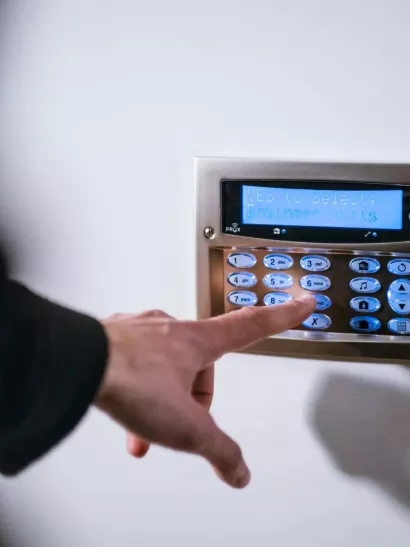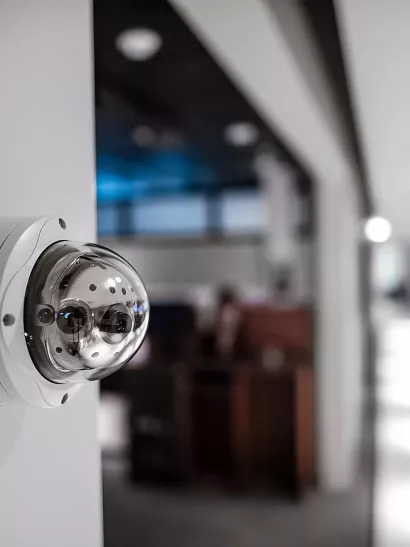The ABCs of Business Security

Your organization’s priority is to keep your employees safe, healthy, and productive. As your organization evolves, the ways you look after your people and assets need to evolve as well. Today’s organizations of all sizes must juggle needs like:
- Managing security systems remotely
- Protecting your people from cyber threats no matter where they are
- Maintaining a safe and healthy work environment in a ever-changing, post-pandemic world
To make the most of your security initiatives, it’s important to understand the fundamentals of relevant technologies, systems, and their capabilities. This post covers:
- What business security is
- Its value to your organization
- The definitions of common business security terms and solutions
Keep reading for valuable insight into the different facets of security and industry-specific terminology.
What is business security?
It’s the infrastructure, technologies, and strategies organizations like yours require to:
Some examples of business security systems are:
- Access Control Systems
- Business Security Camera Systems
- Video Surveillance and CCTV Systems
Organizations rely on security technology like business surveillance cameras, alarm systems, motion detectors, and communication systems for their security initiatives.
Why are business security systems important?
You may already have devices like alarm systems and locks in place. However, do you have contingency plans for disasters like explosions or fires? Can your surveillance systems catch criminals wearing face masks? Do you have touchless doors to help stop the spread of contagions like the coronavirus? You need to integrate the right policies, procedures, and technologies to ensure your employees are safe and healthy.
Secondly, your organization may manage millions or even billions of dollars in assets. You’re maintaining critical and confidential information for your employees and your customers. Security lapses can result in reputational damage and lost revenue. Developing a business security plan will help you minimize risk and stay ahead of threats.
Featured Solutions
Customize A Security Solution for Your Business:
Drive your operations with data analytics.
Create a safer, healthier environment for your school.
Propel your business forward with a comprehensive, integrated commercial security system.
Secure your facility and create a safer, healthier environment for your employees.
Protect the leaders and members of our communities by providing a safe, secure workplace.
Business Security definitions from A-Z
The following are terminology definitions of core concepts in security.
Access Control: A system that secures people, assets, and facilities through limiting access.
Activity Detection: A video motion detection technology that improves the ability to save data for a longer time period by not recording all of the time. It will only record when there is activity or motion in the camera’s field of view.
Alarm Input: A connection from an alarm or sensor that, when activated, triggers the CCTV unit to start recording, generate an audible alert, send an email, etc.
Alarm Malfunction: An alarm signal that is received without the presence of an alarm condition. Also known as a false alarm. Many factors can trigger it including rain, fog, wind, lighting, temperature changes, animals, insects, equipment malfunctions, operator error, and so on.
Baud: The speed at which data are transmitted (i.e., 1 baud = 1 bit per second).
Biometrics: The technology and science of authenticating individuals by measuring psychological or behavioral features.
Blooming: The defocusing of regions of the picture where the brightness is at an excessive level to part of the image.
CCTV (Closed Circuit Television): A system that captures a scene image and transmits it through a display or recording device. The system consists of cameras, recording, and monitoring equipment over a dedicated cabling or transmission system.
CCTV Monitor: A device that receives and displays the picture from the CCTV camera.
Central Station: An alarm system’s control center where subscribers are connected, circuits are supervised, and where personnel can record and investigate alarm or trouble signals. The centers have their own facilities and enable the reporting of alarms to police, fire departments, or other outside agencies.
Coaxial Cable: A particular type of cable capable of passing a wide range of frequencies with very low signal loss. RG59 is a commonly used coaxial cable used for CCTV installations. It’s a stranded metallic shield with a single wire placed along the center of the shield. The wire is isolated from the shield by an insulator.
Day/Night Camera: A regular camera with a highly sensitive CCD chip with the ability to capture quality imagery with very little light.
Detection: The observation of a crime, policy, or procedure violation.
Fail-Safe: A feature of a system or device that initiates an alarm or trouble signal when the system or device either malfunctions or loses power. For example, doors that are normally locked will unlock in the event of a fail-safe condition.
Fail Secure: A feature of a system or device that initiates an alarm or trouble signal when the system or device either malfunctions or loses power. For example, doors will lock in the event of a fail-secure condition. A setting where this would occur is in a prison environment.
False Alarm: An alarm signal that is received without the presence of an alarm condition. Also known as an alarm malfunction. Many factors can trigger it like rain, fog, wind, lighting, temperature changes, etc.
Firewall: A software or hardware application utilized to prevent unauthorized users from accessing a computer. It works as a barrier between networks and ensures that only authorized users are granted access.
Ghost: A spurious issue resulting from an echo. This is when an image moves across a computer screen, leaving a “ghost” image. Badly transmitted coaxial cables cause ghosts.
Hardwired: A direct connection between one product and another. This method is used for the control of equipment in simple systems.
Infrared camera: A camera that captures good images in total darkness due to special infrared lights. The lights are installed around the outside of the camera lens.
Infrared Detector: An alarm that uses infrared light to detect nearby movement.
Insider: A person who knows a facility’s operation and physical security system because of his or her official duties. This person may significantly enhance the likelihood of successful bypass of or defeating of the security surveillance measures of the facility.
IOU: A security surveillance center acronym for a patrol technique: identify, observe, understand.
IP Address: The unique address of a computer or network device connected to that network. IP addresses allow network computers and devices to locate each other and transfer data back and forth. An IP address is required for positive unique identification of any device on a network or the Internet.
IP Camera: An IP camera (or network camera) captures and transmits live video images directly over an IP network. Each camera has a built-in Web server and its own IP address.
Jamming: An intruder’s attempt to prevent radio communications through the destruction of communications equipment. Another way is inserting unwanted signals into the frequency channel of the communications system.
Joystick: A device used to control a PTZ security camera’s pan and tilt head.
LAN (Local Area Network): A high-speed network connecting computers that are in relative proximity to one another. It enables the sharing of resources and data.
Loss Prevention: Also known as shrinkage control. The practice of securing devices or information from theft or loss. Video surveillance is a common loss prevention practice.
Motion Detection: The recording and automated alerts that occur only when motion is perceived. This helps to optimize bandwidth and preserve storage space. Predefined motion detection zones and sensitivity for each camera allow for space to be saved on the hard drive. It can only record relevant events triggered by motion.
Multiplexer: A device that can accept several camera inputs and simultaneously display and record them.
Multiplexing: A technique for the concurrent transmission of two or more signals.
Network: A collection of devices that are connected so that information and resources can be shared. This includes computers, storage devices, printers, etc.
Nuisance Alarm: Any alarm that is not caused by an intrusion. Also referred to as a false alarm or alarm malfunction.
NVR (Network Video Recorder): A recorder that accepts IP camera inputs. NVRs can be software-based, making them suitable for accepting IP camera streams over the Internet.
Object Protection: The protection of objects such as files, safes, or anything of value that could be damaged or removed from a facility.
Pan–tilt–zoom (PTZ): The functions of mounted cameras that can be moved by a controller. The panning of the camera is the movement of the camera horizontally. The tilt is the movement of the camera vertically, and the zoom of the camera is the movement of the camera that magnifies the image.
Photoelectric Alarm System: A system that uses a light beam and a photoelectric sensor to provide a line of protection. Any interruption to the light beam will be detected by the photoelectric sensor. You can use mirrors in this system to change the direction of the beam.
Proprietary Alarm System: An alarm system similar to a central station alarm system except that the annunciator is owned and operated by the facility. The facility ensures that it is constantly maintained and monitored, and all alarm signals and alerts are responded to with notification to the proper authorities.
Protection of Assets: One of the main objectives of the security surveillance center.
Quad: The simultaneous display of four cameras on a single monitor.
Real-time recording: A video with 30 frames per second where there is no hesitation or broken movements in it.
Resolution: The measure of how much detail an image can hold. The higher the resolution, the more detailed are the images.
Response: A security surveillance center reaction to an observation or threat that requires action.
RG-59: A coaxial cable used in CCTV applications.
Silent Alarm: Any technique that allows for an intruder to pass through a sensor’s detection zone without generating an alarm by tricking or fooling its detection system. This means a remote alarm activated without an audible alert such as bells, and horns, etc.
Supervisory Alarm System: A system that monitors conditions and signals for any deviation from an established norm.
Transformer: A device used to transfer electric energy from one circuit to another.
Tri-Shot: A basic security surveillance center camera setup. It’s used to gather and provide the minimum information and evidence needed to determine who, what, when, where, and how.
Trouble Signal: A signal that indicates trouble of any nature. This includes the opening or breaking of an electrical circuit and possible system failure.
UPS (Uninterrupted Power Supply): A method for supplying power without losing data. It allows for the continued operation of a system for a specific time period during a power failure.
Varifocal Lens: A camera lens in which the focus is not fixed. It can be manually adjusted to provide a range of views.
Vibration Sensor: A device that activates when it detects vibrations in its detection zone and then activates a specific surveillance camera.
Video Motion Detection: A system that detects motion in the video signal and generates a corresponding alarm. This feature maximizes recording space by only recording while motion is detected.
Wireless Network Camera: A device that connects to a network wirelessly, allowing for flexible installation in virtually any location. It allows the transmission of data to a receiver without having to run wires.
Zoom: The ability to zero in on specific details. It enables the size of the scene image to be enlarged or reduced.
Empowering Organizations to Stay Safe and Productive
Organizational security requires a holistic approach, from its facilities to its employees to its networks. Beyond tools, it involves specific techniques and approaches. Once you have the knowledge, strategies, and systems, you’ll be able to execute a well-rounded security program.
Connect with Securitas Technology to learn more about the right business security solutions to effectively protect your organization’s people and assets.


























